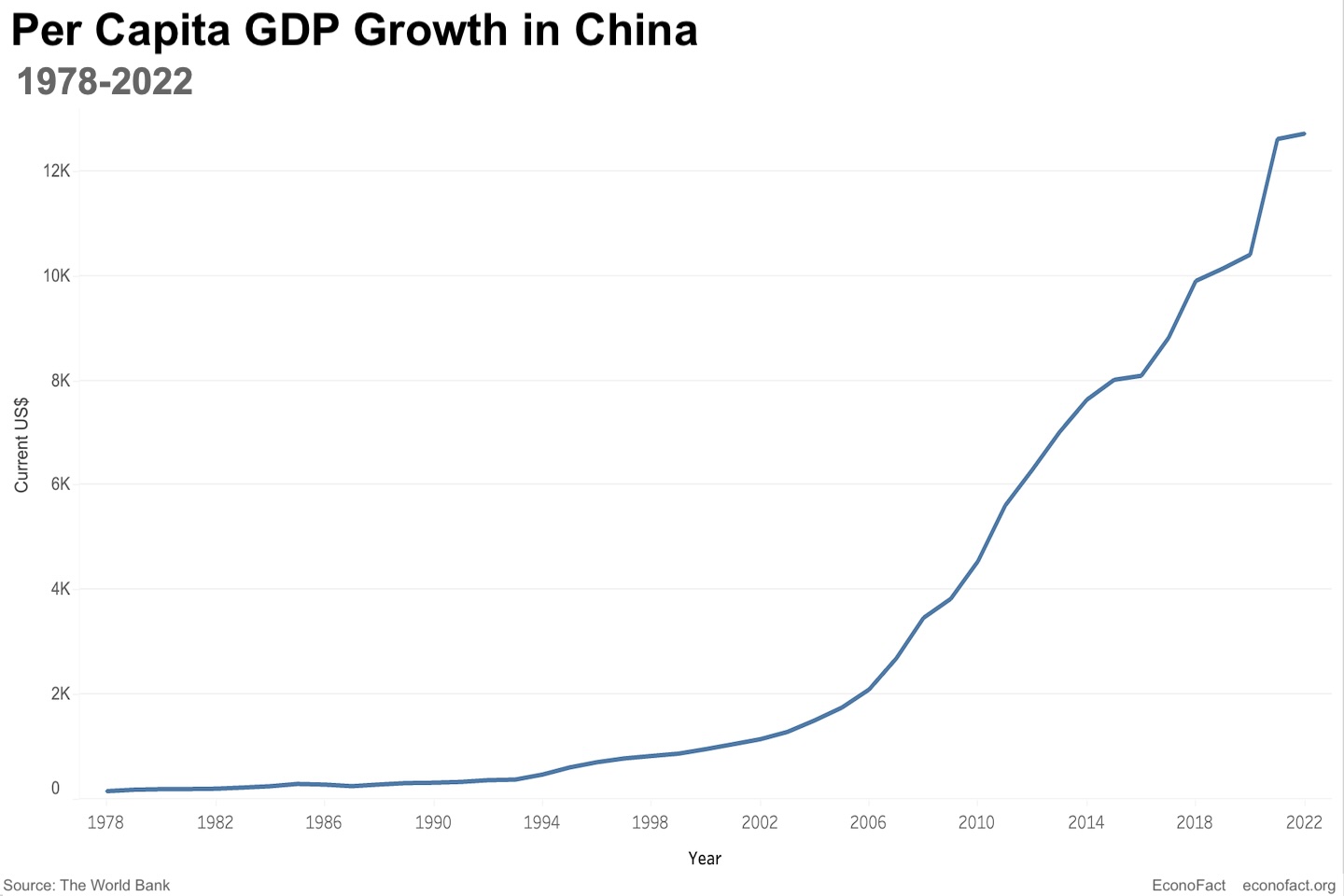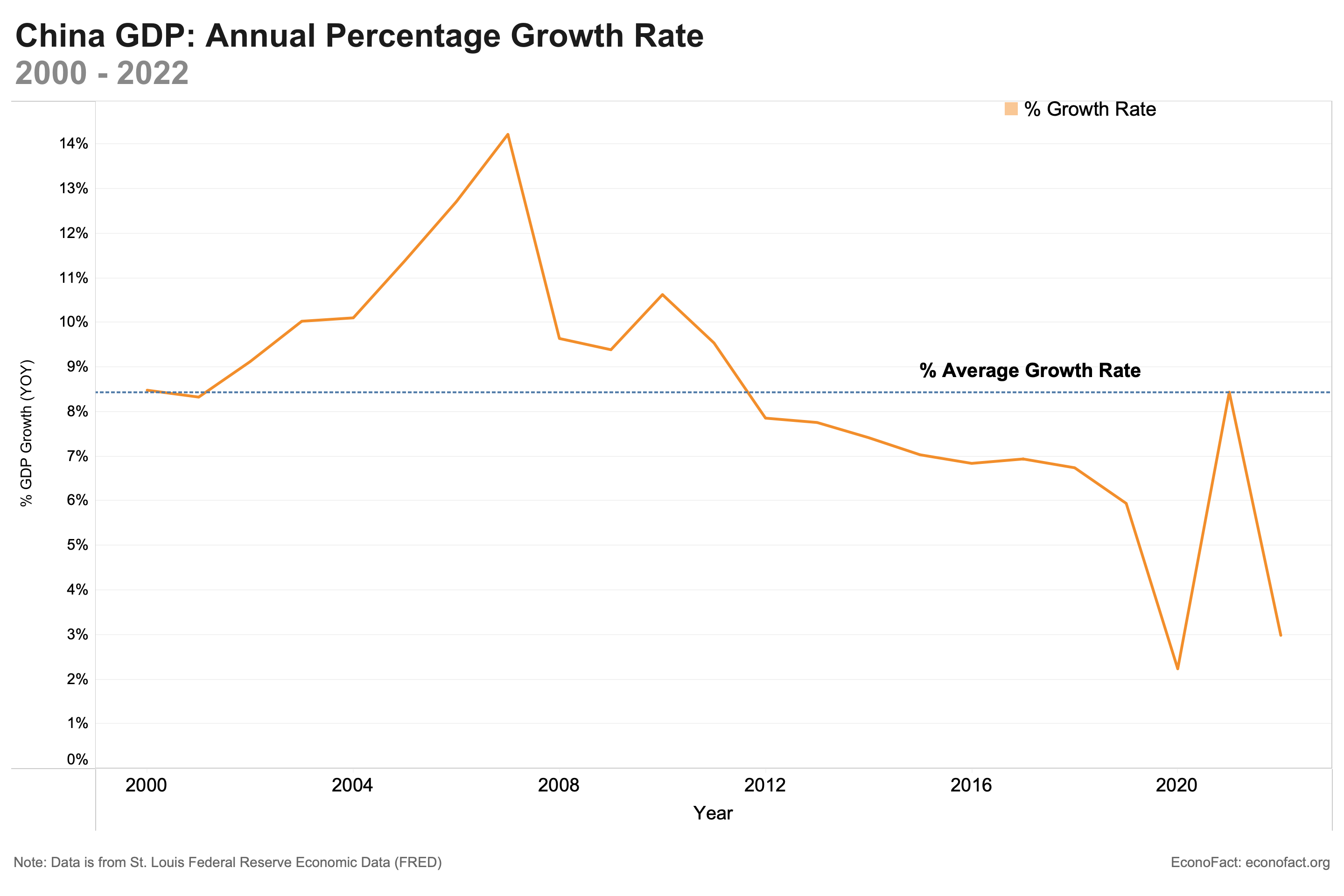What Explains China’s Economic Slowdown? | Econofact
What Explains China’s Economic Slowdown? Econofact


China
University of Pennsylvania
The Issue:
The growth of the Chinese economy over the last four decades is one of the most globally transformative events of the last few centuries. Beginning in 1979, the country has radically transformed from an agrarian economy to one dominated by service and industry, and China stands today as the world’s top trading nation. Recently, however, this “growth miracle” has shown signs of weakening. Even before the country’s COVID shutdowns, growth had begun stalling amid demographic headwinds, an emerging slowdown in the real estate sector, and a re-emergence of state-led economic policymaking. The centralization of power has fed into a worsening relationship with China’s western partners that further threatens the country’s growth prospects.
China’s government began to play a larger role in private enterprise in the 2010s, feeding into a worsening relationship with the West.
The Facts:
- In a little over four decades, China went from being one of the poorest countries in the world — with a real per capita GDP of only $156 US dollars in 1978 — to joining the ranks of upper-middle-income countries with a real per capita GDP of $12,720 in 2022 (see chart below). The growth is particularly striking considering the country’s population size, sweeping territory, and vast heterogeneity. According to national income criteria established by the World Bank, China became a lower-middle-income country in 2001 and transformed into an upper-middle-income country in 2010. Comparing China’s real per capita GDP to the US’s in purchasing power parity (PPP) terms, which takes into account differences in the two countries’ costs of living, China’s has grown from 4.1% of the US per capita GDP level in 1990 to 28.4% of the US level in 2022.

- The Chinese economic growth miracle was, to a large extent, a result of the country’s embrace of market-oriented reforms and globalization. The establishment of formal diplomatic relations with the United States in 1978 paved the way for a virtuous cycle whereby China’s internal reforms gradually decentralized economic decision-making, introduced the market as an increasingly important mechanism for resource allocation, opened the door to foreign investment and significantly increased international trade, which in turn helped to foment further market-oriented changes. The first major reform was the introduction of the household responsibility system, which gave farmers greater autonomy in decision-making. In the 1980s, special economic zones were established in coastal areas. Together with new “open-door” policies, these zones attracted foreign investment and experimented with market-oriented policies. In addition, price reforms were gradually implemented, starting in 1979. In 1992, in its 14th National Congress, the Chinese Communist Party formally incorporated the idea of a market economy into China’s socialist ideology. New reforms — including changes to state ownership of enterprise, the legal system, fiscal policy, and the central bank, as well as the establishment of factor markets, a social safety net, and a personal income tax —made a hybrid market system the economy’s main operating system rather than a mere supplement to central planning. These sweeping and historic market-oriented reforms led to China’s 2001 accession to the World Trade Organization (WTO), which further committed China to additional market liberalization and integration into the global economy. China’s global trade soared and, by 2007, China’s exports had risen to 32 percent of GDP.
- Large productivity gains powered China’s economic growth until 2007. Between 1990 and 2007, China’s productivity grew at an average rate of 4.5% per year. The periods with the fastest productivity growth coincide with the rapid growth of town and village enterprises in the mid-1980s, the state-owned enterprise reform in the mid-1990s, and the explosion of Chinese foreign trade and inbound foreign investment following China’s WTO entry in 2001. Large scale reallocations of labor from agriculture to the manufacturing and service sectors, and of capital from the less-productive state-owned enterprises to more productive private firms, contributed to the growth in productivity.
- Since 2007, China’s productivity growth has stalled at just about 1 percent per year. The global financial crisis of 2007-2009, which originated from the large-scale default of subprime mortgages in the US housing market, shook China’s confidence in the Western-style financial system and may have served as a catalyst for the resurgence of the state-owned enterprises. Before 2008, Chinese local governments were not allowed to borrow; but a 4 trillion RMB stimulus allowed local governments to borrow via local government financing vehicles and become drivers of investment, crowding out private-sector investment (see here). The Four Trillion RMB stimulus rolled out in 2008, followed by an infrastructure investment and housing boom, sustained China’s
SDGs, Targets, and Indicators Analysis
1. Which SDGs are addressed or connected to the issues highlighted in the article?
- SDG 8: Decent Work and Economic Growth
- SDG 9: Industry, Innovation, and Infrastructure
- SDG 10: Reduced Inequalities
- SDG 11: Sustainable Cities and Communities
- SDG 17: Partnerships for the Goals
The article discusses the growth of the Chinese economy, its transformation from an agrarian economy to one dominated by service and industry, and its position as the world’s top trading nation. These issues are connected to SDG 8, which focuses on promoting sustained, inclusive, and sustainable economic growth, full and productive employment, and decent work for all. The article also mentions market-oriented reforms, globalization, and the establishment of special economic zones, which are relevant to SDG 9, which aims to build resilient infrastructure, promote inclusive and sustainable industrialization, and foster innovation. Additionally, the article highlights the challenges faced by China in terms of demographic headwinds and a worsening relationship with Western partners, which relate to SDG 10 (reducing inequalities) and SDG 17 (partnerships for the goals). The mention of the real estate sector and the need for market-deepening reforms also connects to SDG 11, which focuses on making cities and human settlements inclusive, safe, resilient, and sustainable.
2. What specific targets under those SDGs can be identified based on the article’s content?
- Target 8.1: Sustain per capita economic growth in accordance with national circumstances and, in particular, at least 7 percent gross domestic product growth per annum in the least developed countries.
- Target 9.2: Promote inclusive and sustainable industrialization and, by 2030, significantly raise industry’s share of employment and gross domestic product, in line with national circumstances, and double its share in the least developed countries.
- Target 10.4: Adopt policies, especially fiscal, wage, and social protection policies, and progressively achieve greater equality.
- Target 11.3: Enhance inclusive and sustainable urbanization and capacity for participatory, integrated, and sustainable human settlement planning and management in all countries.
- Target 17.16: Enhance the global partnership for sustainable development, complemented by multi-stakeholder partnerships that mobilize and share knowledge, expertise, technology, and financial resources.
Based on the article’s content, these specific targets can be identified. The article mentions the need for sustained economic growth (Target 8.1), the importance of inclusive and sustainable industrialization (Target 9.2), the need to reduce inequalities through policies (Target 10.4), the goal of enhancing urbanization and sustainable human settlement planning (Target 11.3), and the importance of global partnerships for sustainable development (Target 17.16).
3. Are there any indicators mentioned or implied in the article that can be used to measure progress towards the identified targets?
- Per capita GDP growth
- Productivity growth rate
- Foreign direct investment (FDI)
- Trade as a percentage of GDP
- Presence of state cells in corporate governance
The article mentions several indicators that can be used to measure progress towards the identified targets. These include per capita GDP growth, which reflects economic growth and can be used to assess Target 8.1. Productivity growth rate is another indicator mentioned in the article, which is relevant to Target 9.2. The article also discusses foreign direct investment (FDI) and trade as a percentage of GDP, which can be used to measure progress towards various targets related to economic growth and partnerships. Additionally, the presence of state cells in corporate governance is mentioned as an indicator of the Chinese government’s increasing role in private enterprise, which relates to Target 10.4.
SDGs, Targets, and Indicators Table
SDGs Targets Indicators SDG 8: Decent Work and Economic Growth Target 8.1: Sustain per capita economic growth in accordance with national circumstances and, in particular, at least 7 percent gross domestic product growth per annum in the least developed countries. Per capita GDP growth SDG 9: Industry, Innovation, and Infrastructure Target 9.2: Promote inclusive and sustainable industrialization and, by 2030, significantly raise industry’s share of employment and gross domestic product, in line with national circumstances, and double its share in the least developed countries. Productivity growth rate Target 9.5: Enhance scientific research, upgrade the technological capabilities of industrial sectors in all countries, in particular developing countries, including, by 2030, encouraging innovation and substantially increasing the number of research and development workers per 1 million people and public and private research and development spending. Not mentioned in the article SDG 10: Reduced Inequalities Target 10.4: Adopt policies, especially fiscal, wage, and social protection policies, and progressively achieve greater equality. Presence of state cells in corporate governance SDG 11: Sustainable Cities and Communities Target 11.3: Enhance inclusive and sustainable urbanization and capacity for participatory, integrated, and sustainable human settlement planning and management in all countries. Not mentioned in the article SDG 17: Partnerships for the Goals Target 17.16: Enhance the global partnership for sustainable development, complemented by multi-stakeholder partnerships that mobilize and share knowledge, expertise, technology, and financial resources. Foreign direct investment (FDI), trade as a percentage of GDP Behold! This splendid article springs forth from the wellspring of knowledge, shaped by a wondrous proprietary AI technology that delved into a vast ocean of data, illuminating the path towards the Sustainable Development Goals. Remember that all rights are reserved by SDG Investors LLC, empowering us to champion progress together.
Source: econofact.org

Join us, as fellow seekers of change, on a transformative journey at https://sdgtalks.ai/welcome, where you can become a member and actively contribute to shaping a brighter future.








